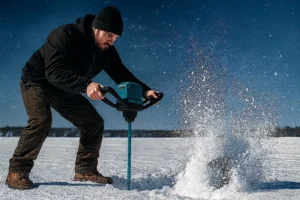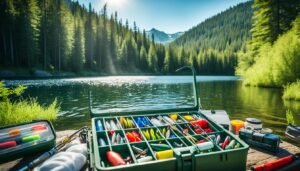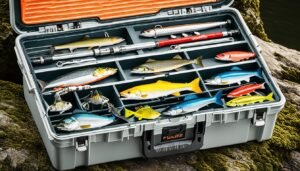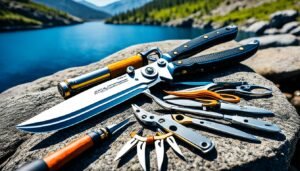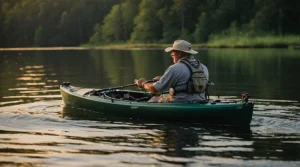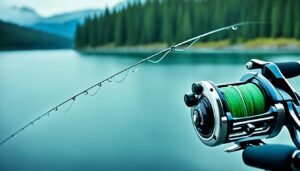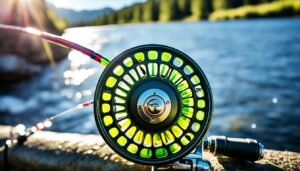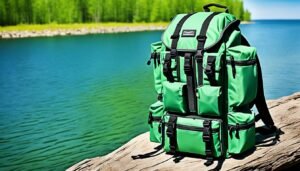When it comes to the art of angling, having the right fishing gear and equipment can make all the difference. From rods and reels to lines and lures, the evolution of fishing tools has a rich historical context. Understanding the significance of using appropriate gear not only enhances the fishing experience but also boosts the chances of a successful catch.
Fishing Gear & Equipment — Summary
Quick picks
Top‑10 gear foundations
- Right rod = control: Match power to fish/cover and action to lure style (see tables).
- Reel fit: Smooth drag, suitable gear ratio (6.2–7.5:1 for most casting; 2500–3000 size spinning).
- Line for the job: Braid for sensitivity/cover, Fluoro for abrasion/stealth, Mono for stretch/topwater.
- Terminal basics: Assortment of hooks, split shot, swivels, snaps, bobber stops, jig heads.
- Core lures: Search (spinnerbait/crank/swimbait), Finesse (wacky/Ned), Vertical (jig/spoon), Topwater.
- Tools: Pliers/forceps, line cutter, hook sharpener, scale, measuring board, fish‑friendly net.
- Organization: 3600/3700 trays, soft bags; label by category (terminal/hard baits/soft baits).
- Safety & comfort: PFD, polarized glasses, hat/sunscreen, first‑aid, headlamp with red mode.
- Maintenance: Rinse salt, dry, oil bearings/levelwind, retie frayed leaders, check guides.
- Local regs: Know seasons, limits, barbless areas. Ethics: quick release, keep fish wet.
Rule: Rod/line/drag are your engine; lures are just different keys.
Efficient fishing gear, including common lures and equipment from top brands, are pivotal for anglers of all levels, whether you’re a seasoned pro or just starting out.
Affiliate Disclaimer: We may earn a commission from purchases made through the links on this page.
Understanding Canadian Waters
Freshwater Fishing
Canada is home to some of the best freshwater fishing spots, including the stunning lakes and rivers of Ontario, Alberta, and British Columbia, where anglers use common lures and specialty gear from bass pro shops. The abundance of freshwater fish species like trout, pike, and walleye make these locations a haven for anglers. Whether you’re casting your line in the serene waters of Lake Ontario or the rushing streams of the Bow River, the thrill of catching a prized fish is unparalleled.
The most common freshwater fish species in Canada include the iconic rainbow trout, renowned for its vibrant colors and impressive fighting spirit. Anglers often target northern pike, known for their aggressive strikes and formidable size. Learning essential freshwater fishing techniques such as fly fishing, baitcasting, and trolling can significantly enhance your chances of landing these prized catches.
Exploring the best freshwater fishing spots near you provides an opportunity to immerse yourself in nature while honing your angling skills. As you navigate through the tranquil lakes or meandering rivers, the anticipation of a successful catch creates an unforgettable experience that resonates with every angler.
Freshwater Fishing Spots | Common Fish Species | Fishing Techniques |
|---|---|---|
Ontario | Rainbow trout, pike | Fly fishing, baitcasting |
Alberta | Pike | Baitcasting, trolling |
British Columbia | Trout, pike, walleye | Fly fishing, trolling |
Choosing Your Gear
Rods and Reels
When it comes to fishing rods, it’s essential to understand the differences between casting and spinning rods. Casting rods are designed for heavier lures and lines, while spinning rods are more versatile and easier to use, especially for beginners. Consider the type of fish you want to catch, the fishing conditions, and common lures when choosing between these two options.

In the world of fishing reels, there are various types available, each with its unique features and common lures. Spincast reels are user-friendly and great for beginners, while baitcasting reels offer more control and accuracy for experienced anglers. Spinning reels provide versatility and are suitable for a wide range of fishing techniques. Consider the specific requirements of your fishing style, including common lures, when selecting a reel that complements your rod choice.
Choosing the right rod and reel combo is crucial for maximizing your fishing experience. For example, if you prefer freshwater fishing for bass, a medium power casting rod paired with a baitcasting reel and common lures could be an ideal combination. Conversely, if you enjoy saltwater fishing for redfish, a medium-light power spinning rod matched with a spinning reel might be more suitable. The key is to ensure that your rod and reel work harmoniously to enhance your fishing performance.
Type of Rod/Reel | Features | Recommended for |
|---|---|---|
Casting Rod | Designed for heavier lures and lines | Experienced anglers, heavier fishing conditions |
Spinning Rod | More versatile and easier to use | Beginners, various fishing conditions |
Spincast Reel | User-friendly, great for beginners | Beginners, simple fishing techniques |
Baitcasting Reel | More control and accuracy | Experienced anglers, precision fishing |
Spinning Reel | Versatile, suitable for a wide range of fishing techniques | All levels of experience, various fishing styles |
Lures and Baits
In the realm of hard bait lures, understanding their applications can significantly impact your fishing success. Crankbaits are excellent for covering large areas of water quickly, while jerkbaits mimic injured baitfish, enticing predatory fish to strike. Topwater lures create exciting surface action, attracting fish in shallow waters. Understanding the behavior of different hard bait lures can help you adapt to various fishing scenarios effectively.
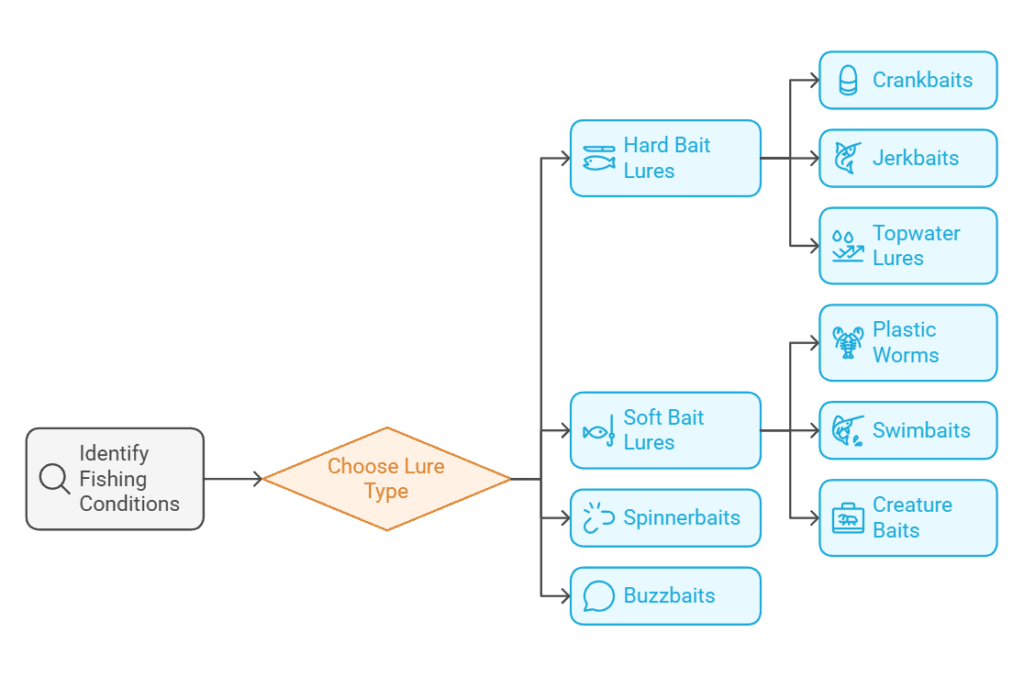
Soft bait lures offer distinct benefits in different fishing conditions. Plastic worms are versatile and can be rigged in multiple ways, making them suitable for various fish species. Soft plastic swimbaits closely resemble live baitfish, making them highly effective in enticing larger predators. Creature baits imitate natural prey, making them valuable in enticing cautious or finicky fish.
The versatility of spinnerbaits and buzzbaits makes them valuable tools for attracting fish in diverse environments. Spinnerbaits excel in covering water quickly and are effective in murky or stained water conditions. On the other hand, buzzbaits create surface commotion, making them perfect for luring fish in low-light or overcast conditions. Understanding how these baits work can significantly enhance your ability to entice fish effectively.
Lines, Hooks, and Weights
Understanding the characteristics of different fishing line types is crucial for optimizing your angling experience. Monofilament lines offer stretchability, making them suitable for topwater fishing and absorbing sudden shocks from aggressive strikes. Fluorocarbon lines provide low visibility underwater, ideal for finesse techniques and clear water conditions. Braided lines offer exceptional strength and sensitivity, beneficial for targeting larger fish species or fishing in heavy cover.
Selecting the right hook size is essential for ensuring proper presentation of your bait. Larger hooks are suitable for bigger baits and targeting larger fish species, while smaller hooks are ideal for finesse techniques or when dealing with cautious fish. Matching the hook size to your bait size ensures a natural appearance and increases your chances of hooking the fish successfully.
Weights play a vital role in adjusting your bait’s depth in the water column. Using heavier weights allows you to reach deeper areas where fish might be holding, while lighter weights enable a more natural presentation in shallow waters. Understanding how weights affect your bait’s movement and positioning can significantly impact your ability to attract fish effectively.
Fishing Gear and Equipment: Quick checklist
1. Choose the Right Rod and Reel
Select a fishing rod and reel combination based on the type of fishing you plan to do. Spinning reels are great for beginners, while baitcasting reels offer more precision for experienced anglers.
2. Use the Correct Fishing Line
Match your fishing line to your target species and environment. Monofilament is versatile, fluorocarbon is nearly invisible underwater, and braided line is ideal for heavy cover and strong fish.
3. Stock Up on Hooks
Keep a variety of hooks, including circle, treble, and J-hooks, in different sizes. Each type works best for specific fishing techniques and target species.
4. Carry a Selection of Lures and Baits
Include crankbaits, jigs, spinners, and soft plastics in your tackle box. Natural bait like worms, minnows, or shrimp can also increase your chances of success.
5. Invest in a Quality Tackle Box
A well-organized tackle box keeps your gear accessible and protected. Choose one with multiple compartments to separate your lures, hooks, and tools.
6. Don’t Forget About Terminal Tackle
Items like swivels, weights, bobbers, and leaders are essential for various fishing techniques. Always have a supply on hand to adapt to changing conditions.
7. Wear the Right Clothing
Dress in layers and wear quick-drying clothing. A wide-brim hat, polarized sunglasses, and sunscreen protect you from the sun while enhancing your visibility and comfort.
8. Use Electronics to Your Advantage
Fish finders and GPS devices help locate fish and navigate unfamiliar waters. These tools are invaluable for both beginners and seasoned anglers.
9. Bring Safety Gear
Pack essentials like a first-aid kit, life jacket, and a whistle. Safety is paramount, especially when fishing from boats or in remote areas.
10. Maintain Your Equipment
Clean and inspect your gear regularly to extend its lifespan. Rinse rods, reels, and lures with fresh water after saltwater fishing to prevent corrosion.
Advanced Equipment
Kayaks and Canoes
Fishing from a kayak or canoe offers several advantages. These watercraft provide access to remote fishing spots that are inaccessible by larger boats. Their maneuverability allows anglers to navigate through narrow waterways, reaching areas where fish tend to gather. The stealthy nature of kayaks and canoes enables anglers to approach fish without spooking them, leading to more successful catches.
When choosing a kayak for fishing, it’s essential to consider the type of water body you’ll be fishing in. For open waters such as lakes or bays, a longer and wider kayak provides stability and ample storage space for fishing gear. On the other hand, for river or stream fishing, a shorter and more maneuverable kayak is preferable for navigating through tight spaces and swift currents.
Essential accessories for kayak and canoe fishing include rod holders, anchor systems, and storage solutions. Rod holders keep your fishing rods secure while you navigate or reel in a catch. Anchor systems help stabilize your watercraft in a particular spot, allowing for precise casting and fishing. Storage solutions like waterproof bags or compartments are crucial for keeping your gear dry and organized during your fishing expeditions.
Tackle Storage Solutions
Innovative tackle storage solutions play a vital role in keeping your fishing gear organized and well-maintained. Proper organization reduces the risk of damage to your equipment and prevents corrosion caused by exposure to moisture. Tackle boxes with adjustable dividers allow you to customize the storage space according to the size of your lures, hooks, and other tackle items.
To protect your fishing equipment from damage and corrosion, consider using rust-resistant tackle boxes made of durable materials such as hard plastics or corrosion-resistant metals. Investing in moisture-absorbing products like silica gel packets helps maintain optimal humidity levels within your tackle storage containers, preventing rust and mold growth on metal components.
For anglers with limited space for storing their fishing gear, compact and space-saving tackle storage options are available. These solutions include soft-sided tackle bags with multiple compartments, collapsible tackle trays, and wall-mounted storage racks. These space-efficient options ensure that even in constrained spaces, every piece of fishing gear has its designated place.
Fly Fishing Gear
Fly fishing requires specialized gear designed to cast lightweight artificial flies accurately. The basic components of fly fishing gear include the fly rod, fly reel, fly line, leader, tippet, and flies. Specialized fly rods are designed to flex and load efficiently when casting light flies, providing precision and delicate presentations essential for enticing selective fish species.
The benefits of using specialized fly fishing gear extend beyond casting accuracy. Fly reels are engineered with smooth drag systems tailored for fighting powerful fish species often targeted by fly anglers. When choosing a fly rod, consider factors such as the rod’s action (flexibility), length, weight (line weight it’s designed for), and material construction (graphite or fiberglass).
Selecting the right fly line is crucial for achieving accurate casts and controlling the presentation of the fly on the water’s surface. Different types of fly lines are available for various fishing conditions, including floating lines for dry fly fishing, sinking lines for nymph or streamer fishing, and specialty lines designed for specific angling techniques.
Apparel for Fishing
Practical Clothing
When planning a fishing trip, choosing the right clothing is crucial. Lightweight, moisture-wicking fabrics are ideal for staying comfortable during long hours on the water. Look for quick-drying shirts and pants to ensure that sudden rain showers or splashes don’t leave you feeling damp and uncomfortable. UV-protective clothing helps shield your skin from harmful sun rays, reducing the risk of sunburn during extended periods outdoors.
For optimal mobility, consider clothing options designed specifically for fishing, such as ventilated fishing shirts and pants with articulated knees. These features allow for unrestricted movement, making it easier to cast lines and reel in catches without feeling restricted by your attire. Furthermore, moisture-wicking socks and breathable footwear are essential to keep your feet dry and comfortable throughout the day.
Rain Gear Essentials
Investing in high-quality rain gear is essential for anglers who fish in various weather conditions. Look for waterproof jackets with sealed seams to prevent water from seeping through during heavy rainfall. Breathable materials ensure that you stay dry without feeling overheated or sweaty underneath the jacket.
When choosing rain gear, consider options with adjustable hoods and cuffs to provide a snug fit and prevent rain from entering through openings. Some jackets also feature zippered ventilation to allow airflow when the weather clears up but the threat of rain lingers. Investing in durable rain gear ensures that you can continue fishing comfortably even when faced with unexpected downpours.
Protective Sunglasses
Wearing polarized sunglasses while fishing is more than just a fashion statement; it’s a vital safety measure. Polarized lenses reduce glare from the water’s surface, allowing anglers to see beneath the water’s reflective surface with clarity. This enhanced visibility makes it easier to spot fish, underwater structures, and potential hazards lurking beneath the water.
When selecting protective sunglasses for fishing, look for options with wraparound frames to minimize peripheral light entering your eyes. Consider sunglasses with impact-resistant lenses to protect your eyes from flying hooks or other potential hazards while casting lines or handling equipment. Whether you prefer sporty designs or classic styles, prioritize sunglasses that offer both UV protection and polarization for a safe and enjoyable fishing experience.
Specialty Fishing Techniques
Bowfishing Gear
Bowfishing, a unique and exhilarating fishing technique, demands specialized gear for a successful adventure. Unlike traditional fishing equipment, bowfishing requires a sturdy compound bow designed specifically for the sport. These bows are equipped with heavy draw weights to penetrate water with force. Paired with specialized reels, they allow anglers to retrieve their catch effortlessly. The arrows used in bowfishing are heavier and connected to a line, ensuring that the fish can be reeled in after being shot. This setup enables anglers to target fish swimming near the water’s surface.
The challenges of bowfishing lie in the need for precise aim and timing. Since the fish are underwater, visibility is limited, making it essential for anglers to possess exceptional accuracy and patience. However, the rewards of this technique are unparalleled. Bowfishing offers an adrenaline rush and a sense of achievement when successfully catching fish using this unconventional method. It also provides an opportunity to engage with nature in a unique and exciting way, making it a favorite among fishing enthusiasts seeking new adventures.
Ice Fishing Tips
When venturing into the world of ice fishing, it’s crucial to be well-prepared with the right gear and knowledge. Successful ice fishing trips rely on specialized equipment such as ice augers, portable shelters, and tip-ups. Ice augers are essential for drilling holes through thick ice, providing access to the water below for fishing. Portable shelters offer protection from harsh weather conditions while providing a comfortable space for anglers to wait for their catch. Tip-ups are mechanical devices that signal when a fish takes the bait, alerting anglers even when they’re not actively watching their lines.
To ensure a fruitful ice fishing experience, anglers should employ effective strategies tailored to this unique environment. Understanding the behavior of fish in cold water is crucial for selecting the right baits and lures. Adjusting techniques such as jigging or deadsticking based on the fish’s activity level can significantly improve catch rates. Safety precautions are also paramount when engaging in ice fishing. Anglers should always check ice thickness before venturing onto frozen bodies of water, wear appropriate clothing for extreme cold conditions, and carry safety equipment such as ice picks and ropes in case of emergencies.
Latest Innovations
New Arrivals
Fishing enthusiasts are always on the lookout for new gear and equipment to enhance their fishing experience. Whether it’s the latest fishing rods, reels, or tackle, staying updated on new arrivals is crucial. By keeping an eye on the market, anglers can benefit from improved designs, materials, and features that cater to specific fishing needs. The industry continually introduces fresh products to meet the evolving demands of anglers worldwide.
Exploring the latest fishing gear means delving into a world of innovation. Manufacturers are constantly striving to develop cutting-edge technologies and materials that improve performance and durability. From advanced reel mechanisms to innovative lure designs, these new arrivals offer anglers a chance to elevate their fishing game. With each new release, companies often provide exclusive deals and promotions, making it an opportune time for anglers to upgrade their equipment without breaking the bank.
For instance, recent advancements in fishing reels have introduced lightweight yet robust materials that enhance casting distance and accuracy. Similarly, new bait designs incorporate lifelike movements and textures to attract fish more effectively. These developments not only make fishing more enjoyable but also increase the chances of a successful catch.
Keeping up with new arrivals also means gaining access to state-of-the-art tools and accessories designed to improve efficiency on the water. From advanced sonar technology for locating fish to ergonomic tackle storage solutions, anglers can optimize their fishing trips with the latest equipment.
Tech in Fishing
The integration of technology has revolutionized the way anglers approach fishing. Tech gadgets such as fish finders and GPS devices have become indispensable tools for modern fishermen. Fish finders use sonar technology to locate fish underwater, providing real-time data on fish depth, size, and location. This invaluable information allows anglers to identify prime fishing spots with precision, significantly increasing their chances of a successful catch.
In addition to fish finders, GPS devices have become essential companions for anglers navigating vast bodies of water. These devices not only help in charting courses but also assist in marking productive fishing locations for future reference. By leveraging GPS technology, fishermen can revisit successful spots with ease, ensuring a more fruitful fishing experience.
Furthermore, technology has extended its influence beyond electronic gadgets by infiltrating traditional fishing equipment. For example, advanced rod and reel designs now incorporate high-performance materials and precision engineering techniques that optimize angler control and fish-fighting capabilities. This blend of traditional expertise with modern technological advancements has resulted in superior gear that enhances both the angler’s experience and their chances of landing prized catches.
Organizing Your Tackle
Tackle Boxes
When it comes to organizing your fishing gear, tackle boxes play a crucial role. Tackle boxes come in various types, including hard plastic, soft-sided, and tackle bags. Each type offers distinct advantages based on the angler’s preferences and fishing style. Hard plastic tackle boxes are durable and provide excellent protection for delicate lures and baits. On the other hand, soft-sided tackle bags offer flexibility and portability, making them ideal for anglers who prefer to cover more ground while fishing.
Customizing your tackle box is essential for efficient organization. By utilizing adjustable dividers, anglers can create specific compartments for different types of lures, hooks, sinkers, and other fishing essentials. This customization ensures that everything has its place, making it easier to locate items during a fishing trip. Labeling compartments with the types of lures or baits stored inside further enhances organization and saves time on the water.
Maintaining your tackle box is crucial for its longevity. Regular cleaning after each fishing trip helps prevent the accumulation of dirt, debris, and moisture, which can damage fishing gear over time. Furthermore, inspecting the tackle box for any signs of wear or damage allows anglers to address issues promptly, ensuring that the tackle box remains in optimal condition for future use.
Bags and Accessories
Fishing bags offer numerous benefits for anglers looking to store and transport their gear efficiently. Fishing bags come in various designs such as backpacks, sling packs, and duffel bags. Backpack-style fishing bags provide ample storage space while offering comfort and convenience during long fishing excursions. Sling packs are compact and allow quick access to gear without having to remove the bag entirely, making them ideal for anglers who need to move swiftly from one spot to another.
In addition to fishing bags, several accessories enhance the overall fishing experience. Essential accessories include line clippers, pliers, hook sharpeners, and bait scent holders. Line clippers allow anglers to quickly cut fishing lines when changing rigs or adjusting leader lengths. Pliers are versatile tools used for removing hooks, crimping split shot weights, and cutting wire leaders. Hook sharpeners ensure that hooks remain razor-sharp for effective hook sets, while bait scent holders help disperse attractants into the water effectively.
Versatility in fishing bag options caters to different fishing styles. For example, fly fishermen may prefer chest packs that keep essential gear easily accessible while wading in rivers or streams. Saltwater anglers often opt for waterproof duffel bags that protect gear from harsh marine environments. Understanding the specific requirements of each fishing style enables anglers to choose the most suitable bag for their needs.
Fishing from Boats
Choosing Kayaks
When selecting a fishing kayak, it’s crucial to consider key factors like stability, maneuverability, and storage options. Look for kayaks with a wider hull for increased stability, especially when reeling in larger fish. Opt for models with ample storage compartments to keep your fishing gear organized and easily accessible.
Different types of kayaks are suitable for various fishing environments. For instance, sit-on-top kayaks are ideal for warmer climates and calm waters, providing easy access for casting lines and reeling in catches. On the other hand, sit-inside kayaks offer better protection from the elements and are suitable for cooler environments or rougher waters.
The right kayak size and design should align with your fishing preferences. Consider the length of the kayak – longer ones provide better tracking and speed, while shorter ones offer improved maneuverability. Moreover, the design features such as pedal-driven propulsion systems can enhance your fishing experience by allowing hands-free operation while navigating to different fishing spots.
Safety Gear
Essential safety gear for fishing excursions includes personal flotation devices (PFDs), which are vital for ensuring safety on the water. It’s important to choose a PFD that is Coast Guard approved and fits comfortably to ensure maximum protection in case of an emergency. Always wear your PFD while on the kayak, even if you are a proficient swimmer.
Understanding safety tips is crucial for preventing accidents and emergencies while fishing. Always check the weather forecast before heading out and be prepared for unexpected changes in conditions. Ensure that you have a communication device such as a waterproof VHF radio or a mobile phone in case you need to call for help. Lastly, inform someone about your fishing plans, including your expected return time and location.
Tips and Tricks
Expert Advice
Fishing enthusiasts seeking to elevate their game can benefit from seeking insights from seasoned fishing experts. These individuals possess a wealth of knowledge and experience that can significantly enhance one’s fishing skills. By tapping into the expertise of these professionals, anglers can gain valuable tips on advanced techniques, strategic approaches, and the latest innovations in fishing gear.
Proven strategies and pro tips shared by experienced anglers can serve as a game-changer for those looking to improve their success rate in fishing. From mastering the art of casting to understanding the behavior of different fish species, expert advice can provide invaluable guidance for anglers at all levels. Furthermore, receiving personalized recommendations on selecting the best fishing gear tailored to specific fishing needs can make a substantial difference in the overall fishing experience.
Engaging with fishing experts not only offers valuable insights but also creates a sense of community among anglers. Sharing experiences, learning from each other, and embracing new perspectives can contribute to a more enriching and fulfilling journey in the world of fishing.
Fishing Enthusiasts | Fishing Experts |
|---|---|
Seek insights from seasoned fishing experts | Possess a wealth of knowledge and experience |
Gain valuable tips on advanced techniques, strategic approaches, and the latest innovations in fishing gear | Share proven strategies and pro tips |
Receive personalized recommendations on selecting the best fishing gear tailored to specific fishing needs | Provide invaluable guidance for anglers at all levels |
Engage with a sense of community among anglers | Share experiences, learn from each other, and embrace new perspectives |
Shopping for Equipment
Finding Deals
When it comes to purchases of fishing gear and equipment, finding the best deals is essential. One way to secure great deals is by keeping an eye out for seasonal sales and promotions. Many top fishing brands offer discounts during key times of the year, such as the end of a fishing season or major holidays like Black Friday.
Subscribing to newsletters or following social media accounts of fishing gear brands can provide exclusive access to special promotions and limited-time offers. These platforms often announce flash sales and discount codes that are not widely advertised. By staying informed about these opportunities, anglers can make significant savings on their fishing gear purchases.
Another effective strategy for securing deals on fishing gear is to explore online marketplaces and auction websites. These platforms often feature new and gently used fishing equipment at discounted prices. Anglers can find high-quality products from reputable brands at a fraction of the original cost, allowing them to stretch their budget further while still obtaining reliable gear.
In addition to traditional retail channels, anglers can also explore local fishing expos and trade shows for exclusive deals on fishing gear and equipment. These events often feature product demonstrations, giveaways, and show-exclusive discounts, providing an excellent opportunity for anglers to interact directly with brands and retailers while taking advantage of special pricing.
Unlocking the Secrets to Scoring Amazing Deals
- Keep an eye out for seasonal sales and promotions from top fishing brands
- Subscribe to newsletters and follow social media accounts for exclusive access to special promotions and limited-time offers
- Explore online marketplaces and auction websites for discounted new and gently used fishing equipment
- Attend local fishing expos and trade shows for exclusive deals on fishing gear and equipment
Brand Selections
When making purchases of fishing gear and equipment, choosing the right brand is crucial for ensuring quality and performance. Some popular fishing gear brands are renowned for their innovative designs, durable materials, and exceptional functionality. Exploring these brands allows anglers to discover the unique offerings and specialties that set them apart in the market.
Each fishing brand has its own strengths, whether it’s advanced reel technology, specialized bait and tackle solutions, or cutting-edge apparel designed for angling comfort. By researching different brands’ reputations and customer reviews, anglers can make informed decisions about which products best suit their specific fishing needs.
Moreover, considering the warranty and customer support offered by fishing gear brands is essential when making purchases. Reliable customer service and comprehensive warranties provide peace of mind to anglers, ensuring that their investment in fishing gear is protected against potential defects or issues that may arise during use.
Summary
You’ve now gained valuable insights into understanding Canadian waters, choosing the right gear and equipment, and exploring advanced techniques and innovations for your fishing adventures. Equipped with the knowledge of specialized apparel, tackle organization, boat fishing, and expert tips, you’re ready to elevate your fishing experience.
Now, it’s time to put this knowledge into action and make the most of your next fishing trip. Whether you’re a seasoned angler or just starting, these tips and techniques will enhance your skills and enjoyment on the water. So grab your gear, head out to the perfect spot, and reel in your next big catch!
External Resources
- For the most up-to-date information on fishing regulations across Canada, always consult the Fisheries and Oceans Canada website.
- You can find a wide selection of fishing gear and equipment at reputable retailers like Bass Pro Shops Canada.
- If you’re planning to fish in Ontario, be sure to familiarize yourself with the specific regulations outlined by the Ontario Ministry of Natural Resources and Forestry.”
FAQ — Fishing gear and equipment
Short. Direct. Actionable.
Keep it simple. Grab a spinning rod and reel combo, 6–7 ft medium power with a 2500–3000 size reel. Spool 8–12 lb mono, add hooks (sizes 6–2), split‑shot sinkers, bobbers/floats, and a few small lures or live bait. Pack needle‑nose pliers, line cutters, a small tackle box, and your fishing license. This kit covers most ponds, lakes, and easy river spots.
Aim for a 6–7 ft medium power, fast‑action spinning rod. It casts well, sets hooks cleanly, and handles common species. Pair it with a 2500–3000 size spinning reel for balanced feel and enough line capacity. For kids, short spincast combos are the easiest to learn. Upgrade later once you know your target species and techniques.
General freshwater: 6–12 lb monofilament works for most beginners. Go lighter (4–8 lb) for trout and panfish; go heavier (12–20 lb mono or 30–50 lb braid) around weeds, docks, or big bass. Keep a small spool of leader (10–20 lb fluoro) if abrasion is an issue. Spool fresh line each season to avoid twist and weak spots.
Start with live bait like earthworms under a float—fast results and easy to rig. Add a few confidence lures: small inline spinners, soft‑plastic grubs on 1/16–1/8 oz jig heads, and a simple topwater popper. Match colors to water clarity: natural in clear, brighter in stained. Rotate until you get bites, then duplicate what worked.
In most places, yes—check your state or provincial regulations and carry a valid license. Essentials: small tackle box, extra hooks/sinkers, spare line, pliers, line cutters, and a rubber‑mesh landing net. Add sun protection (hat, sunscreen), water, and a simple first‑aid kit. Know local rules on bait, limits, and access before you launch.
The Ultimate Guide to the Best Electric Ice Augers for Deep Canadian Snow (2026 Edition)
Discover the best electric ice augers for deep Canadian snow 2026. Expert reviews, real testing data…
Read MoreIce Fishing Gear Essentials: Your Simple Guide
Your simple guide to essential ice fishing gear in Canada. Learn safety tips, clothing needs, and ta…
Read MoreUnforgettable Manitoba Fly In Fishing Adventures: Explore the Untamed Wilderness
Discover thrilling fly-in fishing adventures in Manitoba's pristine lakes and untouched wilderness. …
Read MoreThe Ultimate Guide to Fishing at Night in Ontario: Tips and Tricks for a Successful Experience
Master night fishing in Ontario with tips, gear, and top spots for an unforgettable angling adventur…
Read MoreBest Fishing Bait and Lures for Canada in 2024
Discover the best fishing bait and lures for Canada! Gear up with top-rated tackle for a successful …
Read MorePremium Fishing Tackle Boxes and Storage in 2024
Discover the best Fishing Tackle Boxes and Storage options for Canadian anglers. Find durable, water…
Read MoreBest Fishing Knives and Tools for Anglers in 2024
Gear up with the Best Fishing Knices and Tools – Discover top-rated accessories and quality gear ess…
Read MoreQuality Fishing Tents and Shelters in 2024
Explore top-rated Fishing Tents and Shelters for your next angling adventure. Find durable, waterpro…
Read MorePremium Kayak and Canoe Fishing Gear
Discover top-rated Kayak and Canoe Fishing Gear for superior angling experiences. Equip yourself wit…
Read MoreBest Fishing Lines for Canada – Quality Choices
Discover the Best Fishing Lines for Canada, featuring high performance, durability, and top brands s…
Read MorePremium Fly Fishing Gear and Equipment
Explore our exclusive selection of premium Fly Fishing Gear and Equipment for anglers. Elevate your …
Read MoreBest Fishing Backpacks and Bags
Explore top-rated fishing backpacks and bags for your angling adventures. Find durable, waterproof, …
Read More